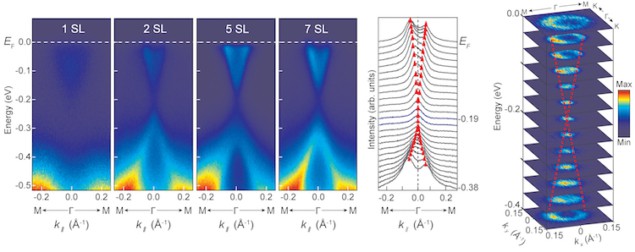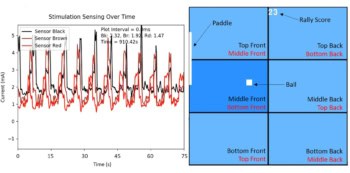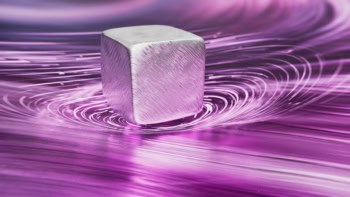
Researchers have discovered the first ever intrinsic magnetic topological insulator – a stoichiometric compound that boasts both inherent magnetic order and topological insulator characteristics. The material, MnBi2Te4, which is made by growing quintuple Bi2Te3 layers and a MnTe bilayer, could be the ideal platform in which to study exotic quantum phenomena such as the quantum anomalous Hall effect (QAHE) and quantum phases like axion insulators at higher temperatures.
Topological insulators are electrical insulators in the bulk but can conduct electricity extremely well on their surface via special, topologically protected, electronic states – hence their name. The materials are predicted to exhibit various exotic quantum effects, but many of these effects can only occur if magnetism is introduced. One example is the QAHE, which is a quantum Hall effect that can occur without an applied magnetic field.
In topological insulators exhibiting the QAHE, electrons can only travel in one direction and do not backscatter. This means that they can carry electrical current with near-zero dissipation of energy and so could be used to make energy-efficient electronic devices in the future. Topological insulators normally need to be doped with magnetic impurities to introduce magnetism into them, but this also introduces strong disorder.
“Such ‘dirty’ materials are a nightmare for researchers studying the quantum effects therein,” explains Ke He of Tsinghua University in Beijing. “Another consequence of the strong disorder is that the temperature at which the QAHE appears is extremely low – at about 0.1 K.”
Intrinsically magnetic topological insulator is stochiometric
An intrinsically magnetic topological insulator solves this problem since it is stochiometric and has orderly arranged magnetic atoms, he adds. “We have now found such a material – a topological insulator with intercalated magnetic layers.”
The researchers used molecular beam epitaxy to grow MnBi2Te4 films. This technique allows them to accurately control film thickness – on the order of one atomic layer, in principle – as well as minimize contamination from the environment.
“For MnBi2Te4, our procedure is a little special,” explains He. “We repeatedly deposit one unit of Bi2Te3 (which includes five atomic layers) and one unit of MnTe (which includes two atomic layers). This leads to MnBi2Te4 spontaneously forming – something that we confirmed in high-resolution transmission electron microscopy images.”
Dirac-cone-shaped surface
The films also have Dirac-cone-shaped surface states, which is characteristic of a 3D topological insulator, he adds. Dirac cones are features in the electronic band structure of a material where the conduction and valence bands meet in a single point. Electrons in these cones behave as though they are relativistic particles with no rest mass, travelling through the material at extremely high speeds – a property that could be exploited to make ultrafast transistors, for example.
The films are magnetic too, which means they can exhibit the QAHE.
“Our theory colleagues have also found several different topological phases that could reside in the material with different thicknesses and magnetic structures,” says He. “The material thus provides us with a perfect platform to study various topological states of matter.”
Quantum effects at higher temperatures
The intrinsically magnetic topologically insulating films are more ordered than their magnetically doped counterparts and could thus exbibit quantum effects at higher temperatures, he adds. “Indeed, recently two groups have observed the QAHE at 1.5 K in exfoliated flake samples of the material, which compares well with the best magnetically doped topological insulator samples. I believe that we could reach higher temperatures by further optimizing the quality of the samples.”
Such a system could be used to explore chiral Majorana modes by depositing a superconductor on the topological insulator, he explains. Majorana modes have zero charge and are their own antiparticles and unlike conventional fermions such as electrons (which obey Fermi–Dirac statistics), Majorana zero modes obey “non-Abelian” statistics. This means that they could be used in quantum computing applications since the quantum information encoded in the particles would be highly resistant to decoherence – a property that is required in any practical quantum computer.
“Although researchers have tried to observe these modes in magnetically doped topological insulator-superconductor junctions, the strong disorder in the materials made interpreting the data difficult,” says He. “Our intrinsically magnetic topological insulator may be better here.”

Ubiquity of topological materials revealed in catalogues containing thousands of substances
Topological magnetoelectric effect
The MnBi2Te4 may also become an axion insulator – the solid-state version of the axion, which is a very interesting elementary particle in high-energy physics, he adds. An axion insulator is expected to show the topological magnetoelectric effect. This is different to the usual magnetoelectric effect in that the coupled electric field and magnetic field are collinear (rather than being perpendicular to each other) and are related by a quantized coefficient. This special effect may have some important applications as well as having implications for metrology.
The researchers, reporting their work in Chin. Phys. Lett. 10.1088/0256-307X/36/7/076801, say they will now be looking into other intrinsically magnetic topological insulators and hope to find the effect in thicker magnetic layers. “Such materials should be more stable in their ferromagnetism thanks to much weaker spin fluctuations than the present single-atomic-layer layer samples and could thus show the QAHE at much higher temperatures than described in our current work,” says He. “I imagine that this temperature could exceed liquid nitrogen temperatures (77 K),” he tells Physics World.



